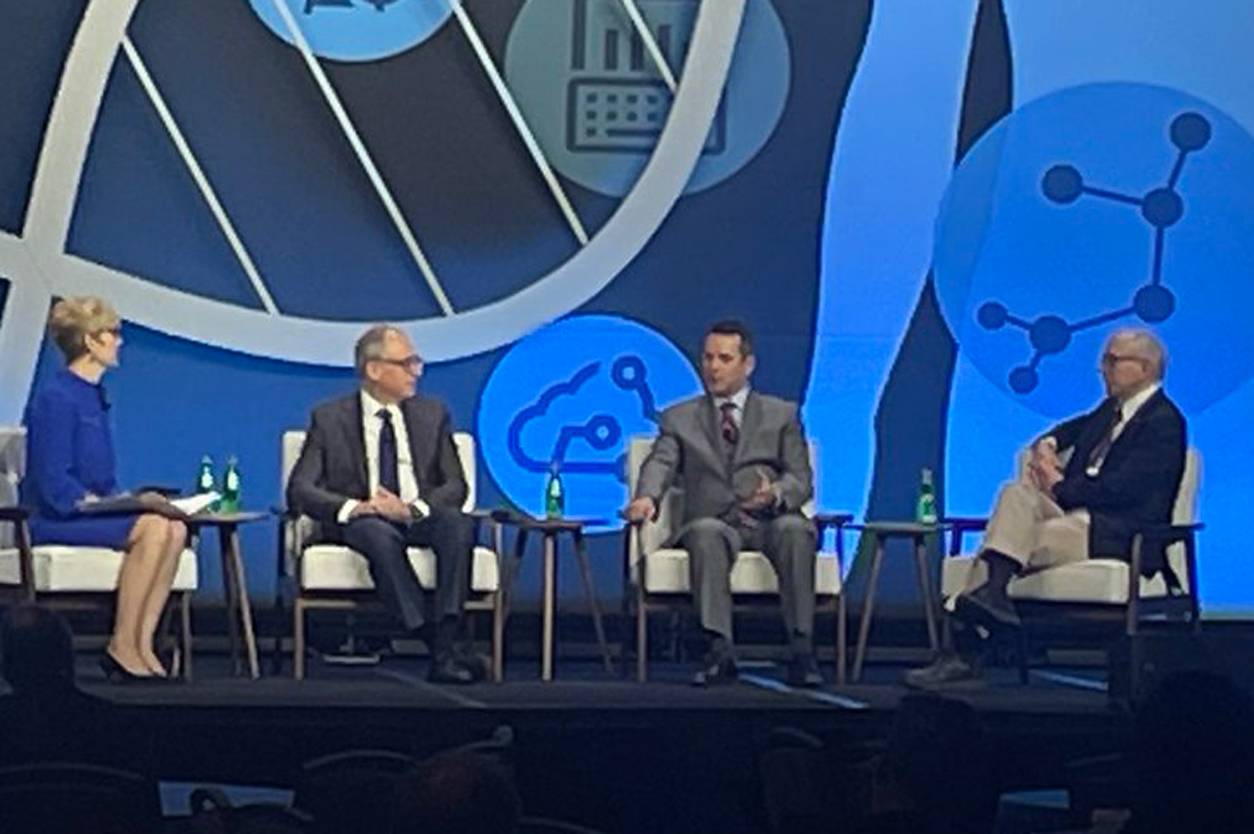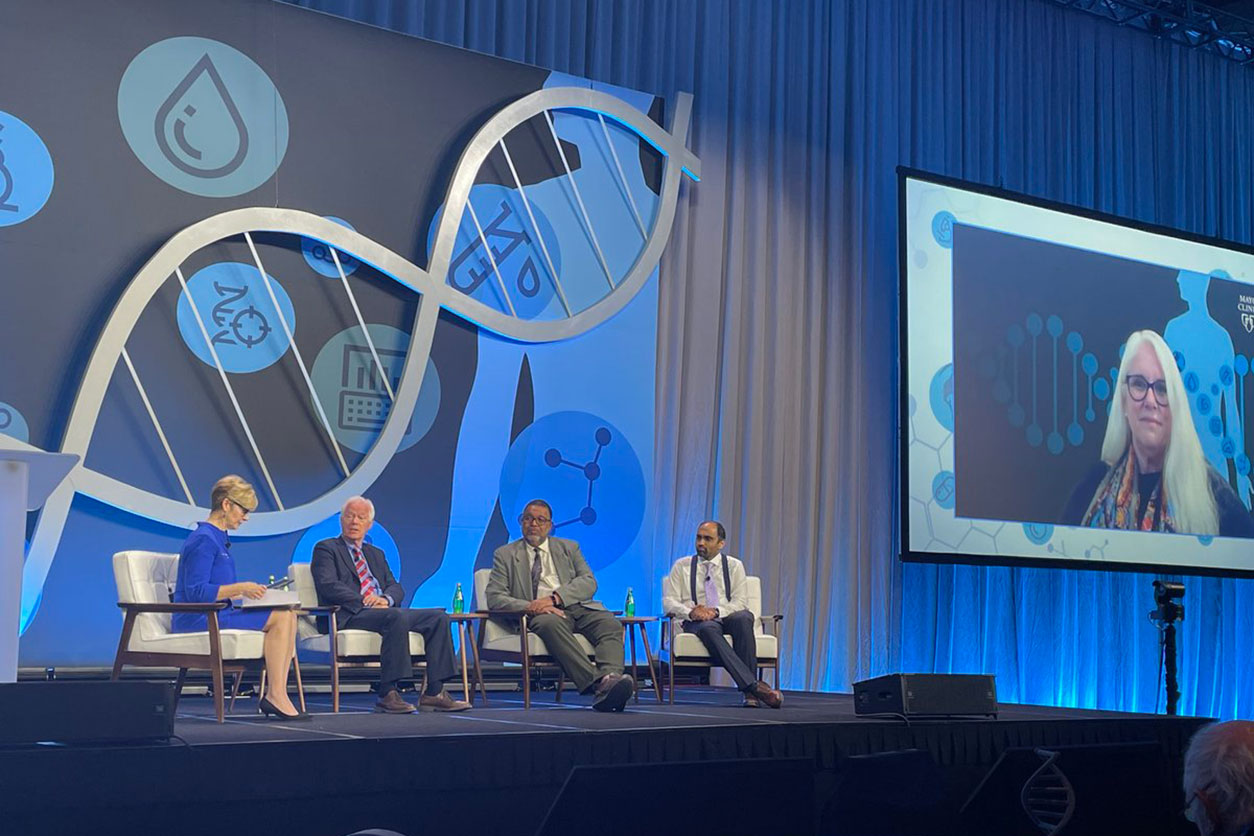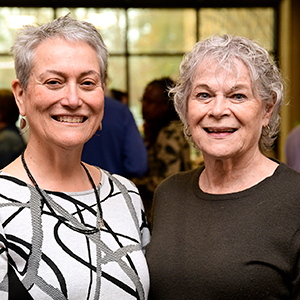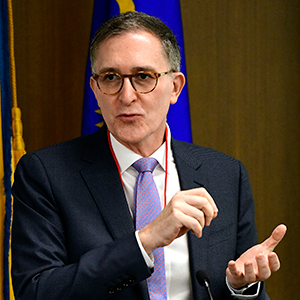“Explore the Exposome: The Next Frontier of Individualizing Medicine” was the title of a Mayo Clinic conference that brought together experts from around the world, including NIEHS leaders and grant recipients, Nov. 2-3 in Rochester, Minn. Participants explored how the exposome — the totality of a person’s exposures throughout life and their corresponding biological effects — can advance human health on a personalized level.
 Left to right: Cathy Wurzer, Konstantinos Lazaridis, M.D., Gary Miller, Ph.D., and Rick Woychik, Ph.D., discussed the exposome during the Mayo Clinic’s 11th Annual Individualizing Medicine Conference. (Photo courtesy of Mayo Clinic Center for Individualized Medicine)
Left to right: Cathy Wurzer, Konstantinos Lazaridis, M.D., Gary Miller, Ph.D., and Rick Woychik, Ph.D., discussed the exposome during the Mayo Clinic’s 11th Annual Individualizing Medicine Conference. (Photo courtesy of Mayo Clinic Center for Individualized Medicine)Accelerating discoveries
“We’ve made significant progress in mapping the human genome and understanding the role of genes in diseases, but genetics only accounts for approximately 10% to 15% of diseases,” said Konstantinos Lazaridis, M.D., executive director of the Mayo Clinic’s Center for Individualized Medicine, in a statement promoting the event. “The key to accelerating further discoveries in individualized medicine lies in putting the exposome under the microscope,” he added.
“To predict individualized health outcomes, you have to factor environmental exposures into the equation,” NIEHS Director Rick Woychik, Ph.D., told attendees. He was joined by NIEHS Deputy Director Trevor Archer, Ph.D., who participated in another panel discussion titled “Exposome Big Data and Translation.”
Woychik has sought to ensure that the environment is factored into projects such as Maps to Mechanisms to Medicine, an initiative by the International Common Disease Alliance to study how genetic traits affect health.
He also highlighted the Human Health and Exposure Analysis Resource (HHEAR), which is funded in part by NIEHS. Through HHEAR, researchers gain access to the tools and infrastructure they need to conduct exposome studies. Woychik then drew attention to the National Institutes of Health All of Us Research Program, which will incorporate analysis of environmental exposures as part of a large-scale effort to promote precision medicine.
Bright future for exposomics
“Some people say, ‘It’s impossible to measure everything that a person has been exposed to throughout their lifetime, so why bother?’” noted NIEHS grantee and Columbia University professor Gary Miller, Ph.D.
 Walker, an NIEHS grantee, discussed an open and fair framework for exposome analysis. (Photo courtesy of Douglas Walker)
Walker, an NIEHS grantee, discussed an open and fair framework for exposome analysis. (Photo courtesy of Douglas Walker)Several years ago, when he taught at Emory University, Miller and his colleague Dean Jones, Ph.D., an NIEHS grantee, who also spoke at the conference, sought to bring clarity to exposomics and show what is possible through such research.
“We proposed a modified definition, which was to get systematic information about cumulative exposures — things we could actually measure — and the corresponding biological responses,” he said. “That is eminently achievable.”
Exposome epidemiology is now beginning to identify health risks based on biomarkers of environmental exposures, noted Jones.
“The key to successful use of precision medicine will be to detect responses to exposures and intervene to improve health outcomes,” he added.
Jones shared his enthusiasm for the conference and optimism about the future of the field.
“I walked away with the very positive feeling that my dream of an international Human Exposome Project could be realized within my lifetime,” he said.
Other NIEHS grantee contributions
Susan Sumner, Ph.D., director of the metabolomics and exposome laboratory at the University of North Carolina at Chapel Hill Nutrition Research Institute, discussed precision nutrition.
 A hybrid panel discussion featured (left to right) Wurzer, Archer, the Mayo Clinic’s Arjun Athreya, Ph.D.; Jones, and Sumner on the big screen. (Photo courtesy of Mayo Clinic Center for Individualized Medicine)
A hybrid panel discussion featured (left to right) Wurzer, Archer, the Mayo Clinic’s Arjun Athreya, Ph.D.; Jones, and Sumner on the big screen. (Photo courtesy of Mayo Clinic Center for Individualized Medicine)“In precision medicine, we often study how some individuals respond well to a drug treatment while others do not have a positive response,” she said. “In precision nutrition, we study individuals’ different nutrient requirements, or their different responses to intake. How an individual responds to nutrients, or to a diet, is related to their health status and to inherited genetics and lifetime exposures. We aim to understand how exposures, or co-exposures, are related to individuals’ responses, and to use this information to discover biological mechanisms as well as pharmacological and nutritional targets.”
“Environmental exposures can influence genetically driven processes, often negatively,” added Miller. “But diet can sometimes help control genetic diseases.”
Barbara Cohn, Ph.D., from the Public Health Institute, described her work based on studies dating from the 1960s, which showed that cumulative exposures during pregnancy can affect at least three generations. “Pregnancy is a vulnerable window of susceptibility for mothers and their offspring,” she said.
Douglas Walker, Ph.D., from the Rollins School of Public Health at Emory University, is working on an exposome-disease atlas that will allow for large-scale profiling of the exposome.
“With millions of samples stored in biobanks and with corresponding geospatial information, we are poised to transform our understanding of the impact of the environment on disease,” he said.
(John Yewell is a contract writer for the NIEHS Office of Communications and Public Liaison.)










